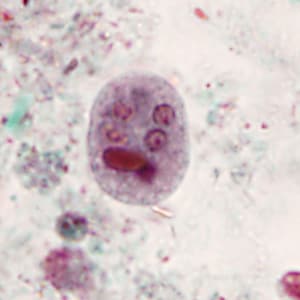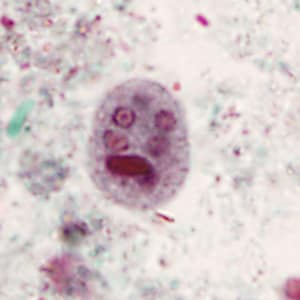
Monthy Case Studies - 2001
Case #61 - June, 2001
A male CDC employee had diarrhea for six weeks before consulting the occupational health clinic. He had traveled to several different African countries a few weeks prior. His symptoms included abdominal cramps and frothy stools. The man treated himself with metronidazole without improvement. A stool specimen preserved in zinc polyvinyl alcohol (Zn-PVA) was submitted to the reference laboratory for diagnostic evaluation. Smears were made from the specimen, stained with trichrome, and examined. Figures A and B show what was observed in moderate numbers; the objects measured on average 15 to 16 micrometers in diameter. What is your diagnosis? Based on what criteria?

Figure A

Figure B
Answer to Case #61
This was a case of amebiasis caused by Entamoeba histolytica/dispar. Some morphologic features of the organisms in this case were not easily seen, possibly because of the medication or poor specimen preservation. Diagnostic features included:
- the size of the cysts, which was consistent with E. histolytica/dispar (12 to 15 micrometers).
- no more than four nuclei present in mature cysts.
- peripheral chromatin of the nuclei that was heavy and fairly even in distribution (in both cysts and trophozoites).
- chromatoid bodies with blunt, rounded ends.
Since E. histolytica and E. dispar are morphologically indistinguishable unless trophozoites have ingested red blood cells (indicating E. histolytica), other tools are needed to differentiate the two species.
More on: Shipping specimens
More on: PCR Techniques for Amebiasis
More on: Amebiasis
Images presented in the monthly case studies are from specimens submitted for diagnosis or archiving. On rare occasions, clinical histories given may be partly fictitious.
 ShareCompartir
ShareCompartir


